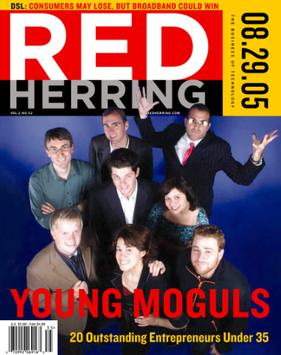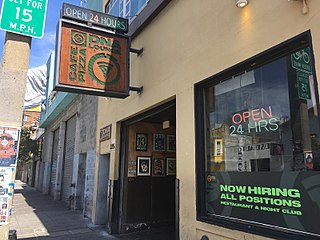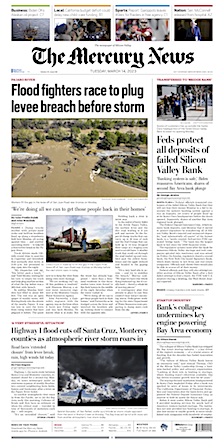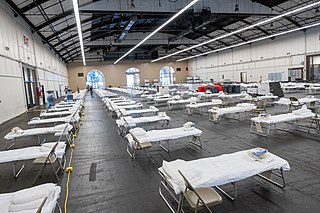
The dot-com bubble was a stock market bubble in the late 1990s. The period coincided with massive growth in Internet adoption, a proliferation of available venture capital, and the rapid growth of valuations in new dot-com startups.

San Francisco, officially the City and County of San Francisco, is the commercial, financial, and cultural center of Northern California. The city proper is the fourth most populous city in California, with 808,437 residents, and the 17th most populous city in the United States as of 2022. The city covers a land area of 46.9 square miles at the end of the San Francisco Peninsula, making it the second most densely populated large U.S. city after New York City and the fifth-most densely populated U.S. county, behind only four of the five New York City boroughs. Among the 91 U.S. cities proper with over 250,000 residents, San Francisco was ranked first by per capita income and sixth by aggregate income as of 2021. Colloquial nicknames for San Francisco include Frisco, San Fran, The City, and SF.

Red Herring is a media company that at different times has published a magazine about tech innovation, an online daily technology news service, and technology newsletters, and has hosted events for technology leaders.

DNA Lounge is an all-ages nightclub and restaurant/cafe in the SoMa district of San Francisco owned by Jamie Zawinski, a former Netscape programmer and open-source software hacker. The club features DJ dancing, live music, burlesque performances, and occasionally conferences, private parties, and film premieres.

The Mercury News is a morning daily newspaper published in San Jose, California, in the San Francisco Bay Area. It is published by the Bay Area News Group, a subsidiary of Digital First Media. As of March 2013, it was the fifth largest daily newspaper in the United States, with a daily circulation of 611,194. As of 2018, the paper has a circulation of 324,500 daily and 415,200 on Sundays. As of 2021, this further declined. The Bay Area News Group no longer reports its circulation, but rather "readership". For 2021, they reported a "readership" of 312,700 adults daily.
The Mission District, commonly known as The Mission, is a neighborhood in San Francisco, California. One of the oldest neighborhoods in San Francisco, the Mission District's name is derived from Mission San Francisco de Asís, built in 1776 by the Spanish. The Mission is historically one of the most notable centers of the city's Chicano/Mexican-American community.

Pink Saturday is a street party held the Saturday night before San Francisco Pride in San Francisco's Castro district. It coincides with the annual Dyke March in San Francisco.

Frank Chu is an American eccentric and conspiracy theorist. Since 1999 or earlier, Chu has been campaigning to impeach an array of former U.S. Presidents he considers guilty of collaborating with a nefarious network of alien populations called the "12 Galaxies" to film him against his will, to broadcast this footage intergalactically, and to embezzle the royalties he is owed as a television and movie star. Chu lives in Oakland, and commutes daily to San Francisco and nearby locales in order to reach the largest audience of passers-by and television news crews for his street protests about this labor dispute. He produces a new sign weekly through Signographics in San Francisco and supports himself through sign sponsorships and small donations from his supporters and with help from his family.

South Park is a small urban park and eponymous neighborhood in the larger South of Market neighborhood of San Francisco, California, consisting of 0.85 acres of public ground. The neighborhood centers on the small, oval-shaped park and South Park Street, which encircles the park. South Park is bounded by Second, Third, Bryant, and Brannan streets.

The EndUp is a nightclub in San Francisco, California. Opened in 1973, the club is located at 6th Street and Harrison in the South of Market district. Known for its status as an afterhours club, the venue has hosted a variety of benefits and events during its time as part of San Francisco's nightlife community.

The San Francisco Armory, also known as the San Francisco National Guard Armory and Arsenal or simply The Armory, is a historic building in the Mission District of San Francisco, California. Since 2018, it has been owned by SF Armory LLC, an affiliate of AJ Capital Partners.

The media in the San Francisco Bay Area has historically focused on San Francisco but also includes two other major media centers, Oakland and San Jose. The Federal Communications Commission, Nielsen Media Research, and other similar media organizations treat the San Francisco-Oakland-San Jose Area as one entire media market. The region hosts to one of the oldest radio stations in the United States still in existence, KCBS (AM) (740 kHz), founded by engineer Charles Herrold in 1909. As the home of Silicon Valley, the Bay Area is also a technologically advanced and innovative region, with many companies involved with Internet media or influential websites.
Held in San Francisco's Masonic Center for a crowd of 3,000 invited guests, the 2000 Webby Awards were widely considered the peak of the Webby Awards and a watershed of dot-com party culture. The event took place May 11, 2000, shortly before many of the event's perennial nominees and participants suffered business failures in the dot com crash.
Audrey Joseph is an American record executive, nightclub owner and manager, and LGBT rights activist.

The San Francisco Bay Area, commonly known as the Bay Area, is a region of California based around San Francisco Bay, including both the San Pablo Bay, and Suisun Bay estuaries, in Northern California. The Bay Area is defined by the Association of Bay Area Governments to include the nine counties that border the aforementioned estuaries: Alameda, Contra Costa, Marin, Napa, San Mateo, Santa Clara, Solano, Sonoma, and San Francisco. Other definitions may be either smaller or larger, and may include neighboring counties that do not border the bay such as Santa Cruz and San Benito ; or San Joaquin, Merced, and Stanislaus. The most populous cities of the Bay Area are Oakland, San Francisco, and San Jose.
A dot-com party is a social and business networking party hosted by an Internet-related business, typically for promotional purposes or to celebrate a corporate event such as a product launch, venture funding round, or corporate acquisition.

Jane Jungyon Kim is an American attorney and politician, and the first Korean American elected official in San Francisco. She represented San Francisco's District 6 on the Board of Supervisors between 2011 and 2019. She is a member of the San Francisco's Democratic County Central Committee. She is executive director of the California Working Families Party.

The gentrification of San Francisco has been an ongoing source of tension between renters and working people who live in the city as well as real estate interests. A result of this conflict has been an emerging antagonism between longtime working-class residents of the city and the influx of new tech workers. A major increase of gentrification in San Francisco has been attributed to the Dot-Com Boom in the 1990s, creating a strong demand for skilled tech workers from local startups and close by Silicon Valley businesses leading to rising standards of living. As a result, a large influx of new workers in the internet and technology sector began to contribute to the gentrification of historically poor immigrant neighborhoods such as the Mission District. During this time San Francisco began a transformation eventually culminating in it becoming the most expensive city to live in the United States.

El Rio is a gay bar located at 3158 Mission Street, San Francisco, California. It was the first gay bar to debut queer salsa in San Francisco. El Río was established in 1978 as a Leather Brazilian Gay Bar and has been recognized as a Legacy Business by the San Francisco Small Business Commission. El Rio is best known for supporting the community by providing a space for community gatherings, LGBT performances, diverse forms of music and dancing, and offering a space for community fundraising events.

The San Francisco Bay Area, which includes the major cities of San Jose, San Francisco, and Oakland, was an early center of the COVID-19 pandemic in California. The first case of COVID-19 in the area was confirmed in Santa Clara County on January 31, 2020. A Santa Clara County resident was the earliest known death caused by COVID-19 in the United States, on February 6, suggesting that community spread of COVID-19 had been occurring long before any actual documented case. This article covers the 13 members of ABAHO, which includes the nine-county Bay Area plus the counties of Monterey, San Benito, and Santa Cruz.
















